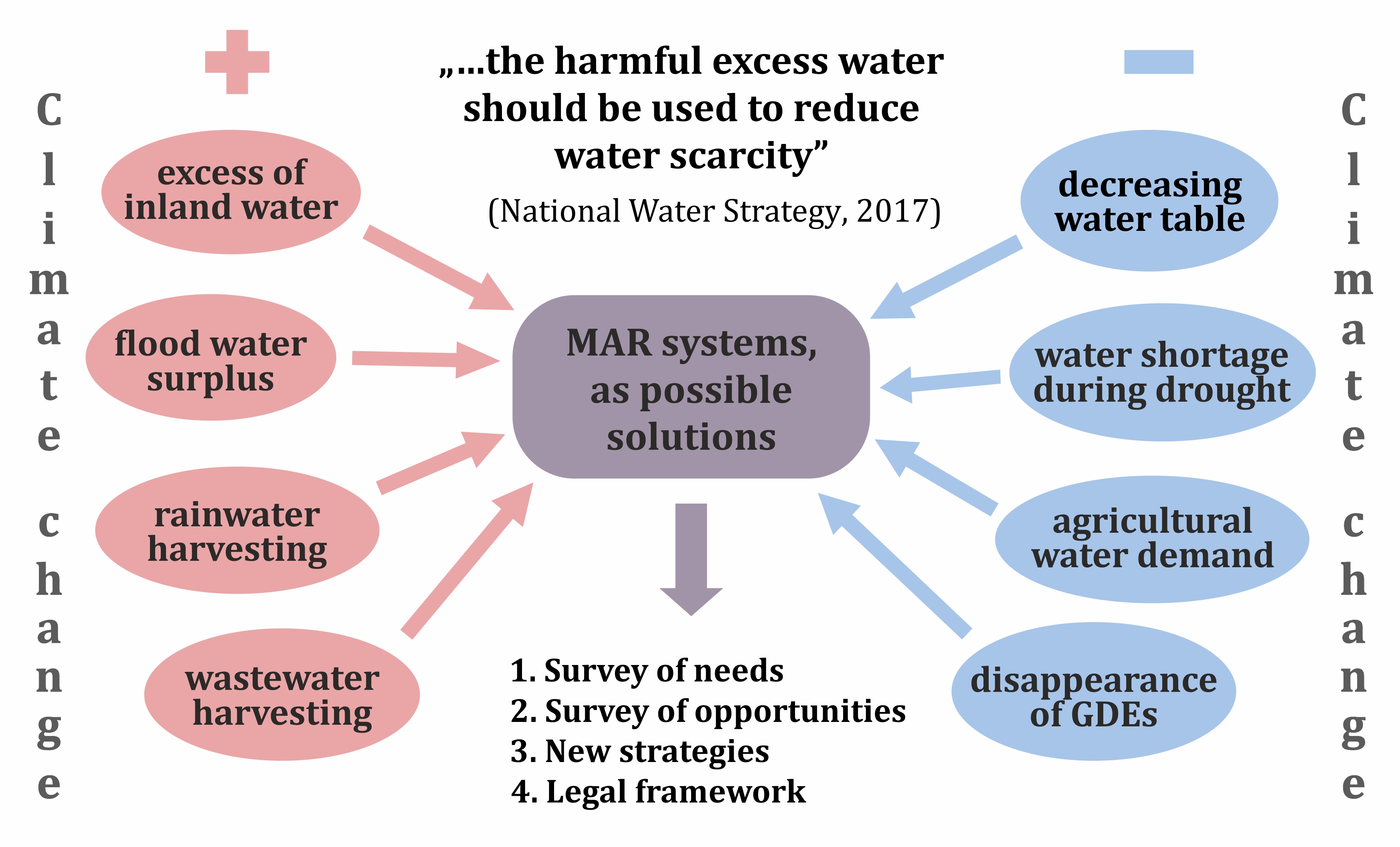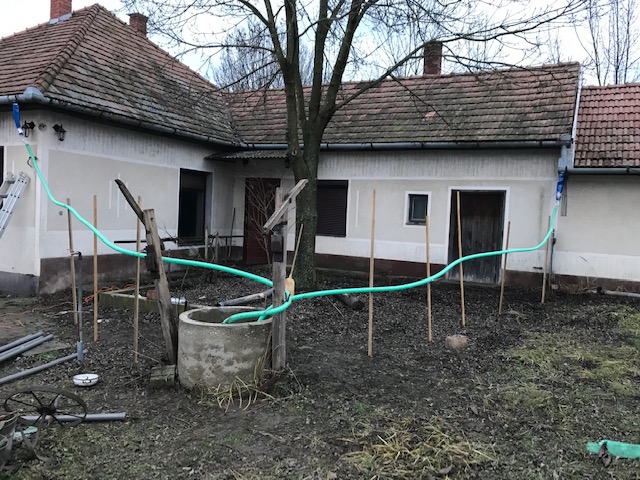
Managed Aquifer Recharge using rooftop rainwater harvesting and shallow well infiltration in Kerekegyháza, Hungary
Szabó Zsóka, III. year PhD-student
Doctoral School of Environmental Sciences - Environmental geology
Supervisor: Mádlné Dr. Szőnyi Judit, associate professor, Department of Geology
In Hungary, water retention and enhanced groundwater recharge will play an increasingly important role in adapting to climate change. Especially given that Hungary is a transit country, regarding surface waters: 95% of the water flowing out of the country comes from abroad and only 5% comes from local surface runoff. Thus, the amount of precipitation in the country is often considered negligible, although by retaining it, significant water reserves could be accumulated (Somlyódy 2011).
There is a growing need for the development of municipal rainwater and stormwater management, from all sides (residents, municipalities, public utilities, water directorates, etc.) to avoid flash floods and related geoengineering problems, and to preserve water for droughts. Rainwater management is also necessary from a protection point of view, but it is equally important to retain water and thus adapt to climate change (Bíró 2019, Gayer 2019).

Figure 1: Possibilities of using Managed Aquifer Recharge in Hungary, considering the water management challenges in the country (translated from Szabó et al. 2020)
The primary research area is the broader area of Kerekegyháza settlement, near Kecskemét, which is located in the ridge region of the Duna-Tisza Interfluve. Water management problems in the broader area have been known for decades (e.g. Major and Neppel 1988, Pálfai 1995, Ladányi et al. 2009, Kovács et al. 2017) and are still unsolved (VGT3-JVK discussion material 2020). Climate change and anthropogenic effects (canalization, afforestation, water abstraction, etc.) have played and continue to play a significant role in the development and persistence of the problem. In the past, several replenishment plans have been prepared, involving large, cross-regional technical investments, but have not been implemented due to the lack of adequate financial resources (e.g. Duna-Tisza canal, Orlóci 2003). Decreasing groundwater levels have been observed in Kerekegyháza as well. Most of the dug wells have dried out or the water level has decreased by several meters in recent decades, furthermore Lake Kondor, southwest of the settlement, dried out as well.
The aim of this research is to evaluate the water replenishment possibilities of the area from a different perspective by investigating local water replenishment methods, which have many advantages. Among others, these solutions are cheaper to implement, have a lower impact on the environment, the effects can be determined more easily and are easier to control, and therefore they carry less risk.
One possible solution could be to collect and infiltrate rainwater, which is one of several Managed Aquifer Recharge (MAR) methods. MAR, by definition, is the purposeful recharge of water to aquifers for subsequent recovery or environmental benefit (NRMMC, EPHC, NHMRC 2009). It is a group of nature-inspired approaches that promote the accumulation of water reserves under the surface, and support the joint management of surface waters and groundwaters. This can be an effective way to mitigate climate change extremes and thus contribute to climate change adaptation (Evans and Dillon 2018, Dillon et al. 2018).
Rainwater collected from the roof can be infiltrated via ponds, basins and ditches through the unsaturated zone or using wells thus leading water directly to the saturated zone (Dillon et al. 2009). The latter solution has several advantages, including lower evaporative water loss, faster increase of groundwater level, smaller surface area, and lower risk of biological activity and thus contamination (Page et al. 2018). In the frame of this research, the applicability of this method is investigated in the area of Kerekegyháza by continuously monitoring an experimental pilot project, analyzing the collected time series data, and building numerical groundwater flow models.

Figure 2: Experimental rooftop rainwater harvesting system that delivers the collected rainfall to the subsurface using a dug well in the garden
A field experiment was set up to lead rainwater from the roof of a family house to the dug well in the yard. Water level, temperature and specific electrical conductivity is recorded every half hour in the dug well and in two newly established observation wells. Precipitation is measured on a daily basis. Based on the obtained time-series data and the results of the laboratory measurements of the collected water samples, the effects of injected water on water levels and water quality was analyized. Moreover, a transient MODFLOW model was built to understand the occuring underground processes. The obtained results can help to understand the effects of rainwater harvesting through shallow well infiltration, provide background information for further numerical simulations and contribute to expand the design of similar systems on settlement and regional level.
This research is part of a project that has received funding from the European Union's Horizon 2020 research and innovation programme under grant agreement No 810980.
Selected literature:
- Bíró, T. (ed.) (2019). Országos Települési Csapadékvíz-gazdálkodási Konferencia Tanulmányok. Dialóg Campus Kiadó, Budapest, 306 p.
- Dillon, P., Pavelic, P., Page, D., Beringen, H., Ward, J. (2009). Managed aquifer recharge. An introduction waterlines report series 13, 86 p.
- Dillon, P., Stuyfzand, P., Grischek, T., Lluria, M., Pyne, R. D. G., Jain, R. C., Bear, J., Schwarz, J., Wang, W., Fernandez, E., Stefan, C., Pettenati, M., van der Gun, J., Sprenger, C., Massmann, G., Scanlon B. R., Xanke, J., Jokela, P., Zheng, Y., Rossetto, R., Shamrukh, M., Pavelic, P., Murray, E., Ross, A., Bonilla Valverde, J. P., Palma Nava, A., Ansems, N., Posavec, K., Ha, K., Martin, R., Sapiano, M. (2018). Sixty years of global progress in managed aquifer recharge. Hydrogeology Journal, 27(1), 1-30.
- Evans, R. S., Dillon, P. (2018). Linking groundwater and surface water: conjunctive water management. In: Advances in Groundwater Governance, Villholth, K. G., López-Gunn, E., Conti, K. I., Garrido, A., van der Gun, J. (eds.), CRC Press, London, pp. 329-351.
- Gayer, J. (2019). Gondolatok a települési csapadékvízről. Hidrológiai Közlöny, 99(3), 77-79.
- Kovács, A. D., Hoyk, E., Farkas, J. Z. (2017). Homokhátság–A semi-arid region facing with complex problems in the Carpathian Basin. European Countryside, 9(1), 29-50.
- Ladányi, Z., Rakonczai, J., Kovács, F., Geiger, J., Deák, J. Á. (2009). The Effect of Recent Climatic Change on the Great Hungarian Plain. Cereal Research Communications, 37, 477-480.
- Major, P., Neppel, F. (1988). A Duna-Tisza közi talajvízszint-süllyedések. Vízügyi Közlemények, 70(4), 605-623.
- NRMMC, EPHC, NHMRC (2009). Australian Guidelines for water recycling, managing health and environmental risks, vol 2C: managed aquifer recharge. Natural Resource Management Ministerial Council, Environment Protection and Heritage Council, National Health and Medical Research Council, 237 p.
- Orlóci, I. (2003). A Tiszát a Dunával összekötő csatorna: a Duna-Tisza csatorna. Hidrológiai Közlöny, 87(4), 243-250.
- Page, D., Bekele, E., Vanderzalm, J., Sidhu, J. (2018). Managed aquifer recharge (MAR) in sustainable urban water management. Water, 10(3), 239
- Pálfai, I. (1995). A Duna-Tisza közi hátság vízgazdálkodási problémái és megoldásuk lehetséges útjai. Vízügyi Közlemények, 77(2), 144-165.
- Ridavits, T. (2020). Célzott felszínalatti vízutánpótlás tetővízből Kerekegyházán, a Duna-Tisza közi Homokhátság területén. MSc diplomamunka, Eötvös Loránd Tudományegyetem, 139 p.
- Somlyódy, L. (ed.) (2011). Magyarország vízgazdálkodása: helyzetkép és stratégiai feladatok. Magyar Tudományos Akadémia, Budapest, 332 p.
- Szabó, Zs., Tahy, Á., Mádlné Szőnyi, J. (2020). A célzott felszín alatti vízutánpótlás nemzetközi trendjei és hazai alkalmazási lehetőségei. Hidrológiai Közlöny, 100(4), 40-51.
- VGT3 JVK discussion material (2020). Magyarország 2022–2027 időszakra vonatkozó, harmadik Vízgyűjtő-gazdálkodási Tervének Jelentős Vízgazdálkodási Kérdéseinek vitaanyaga: http://vizeink.hu/vizgyujto-gazdalkodasi-terv-2019-2021/jelentos-vizgazdalkodasi-kerdesek-jvk/ (Accessed: 2020.05.18.)

